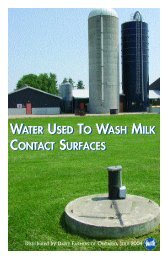Canadian Quality Milk On-Farm Food Safety Program - Centre ...
Canadian Quality Milk On-Farm Food Safety Program - Centre ...
Canadian Quality Milk On-Farm Food Safety Program - Centre ...
You also want an ePaper? Increase the reach of your titles
YUMPU automatically turns print PDFs into web optimized ePapers that Google loves.
<strong>Canadian</strong> <strong>Quality</strong> <strong>Milk</strong><br />
HAZARD SOURCE BEST MANAGEMENT PRACTICES<br />
Pesticides<br />
e.g. insecticides,<br />
rodenticides, avicides<br />
and herbicides<br />
Volatile organic<br />
compounds in water<br />
• Treated pasture or crops<br />
• <strong>Milk</strong> house and barns<br />
• Treated seed<br />
• Backflow into hoses<br />
used to fill pesticide<br />
sprayers<br />
• Improper pesticide<br />
storage<br />
Fertilizers • Spilled bulk fertilizer<br />
Use only pesticides registered for use in<br />
pastures, forages, milk houses and barns in<br />
those respective areas.<br />
Follow all pesticide label directions and watch for<br />
“Days to Grazing” or “Days to Harvest” warnings.<br />
Use an anti-backflow device on hoses connected<br />
to milk house and barn water supply.<br />
Maintain a valid, up-to-date pesticide safety<br />
certificate where required.<br />
Keep accurate records of pesticides used.<br />
Properly locate pesticide handling facility.<br />
Communicate effectively with family and staff at<br />
all times about residue hazards.<br />
Prevent cross-contamination of feeds.<br />
Use labs and test kits for suspected<br />
contaminants.<br />
Store and use pesticides in a safe and secure<br />
manner in original containers in a manner that<br />
does not contaminate water.<br />
Have a written plan outlining how to deal with a<br />
situation where water becomes contaminated<br />
with pesticides.<br />
Test water and verify source.<br />
See Chapter 1.<br />
Store pesticides and treated seed in a safe and<br />
secure manner in original containers, away from<br />
livestock access, feed, feed storage and milking<br />
equipment.<br />
Store treated seeds separately from feed<br />
ingredients.<br />
See Chapter 1.<br />
• Spill or leak Follow proper spill cleanup procedures.<br />
See Chapter 1.<br />
• Fuel storage leak Have a written plan on how to deal with a situation<br />
•<br />
where your water source becomes contaminated.<br />
Workshops and machine<br />
sheds<br />
Test water and verify source.<br />
• Industrial landfill Contain and clean up spills.<br />
Upgrade storage features.<br />
Inspect and repair well casing.<br />
Relocate well.<br />
See Chapter 7.<br />
Store fertilizers in a safe and secure manner in<br />
• Cross-contamination<br />
original containers, away from livestock access,<br />
feed storage and milking equipment.<br />
Appendix I - 6<br />
June 2010
















